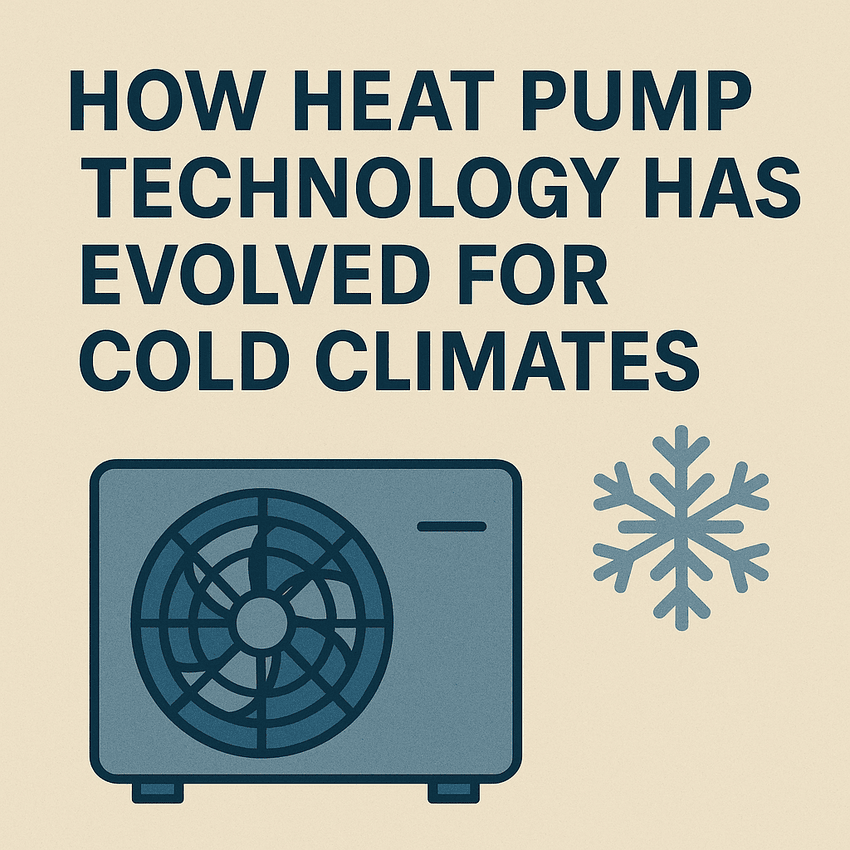Introduction: The Rising Demand for Cold-Climate Heat Pumps
For decades, heat pumps were considered impractical in extremely cold regions, often losing efficiency when temperatures dropped below freezing. However, with growing demand for eco-friendly heating solutions, researchers and manufacturers have innovated to design cold-climate heat pumps (CCHPs) that perform efficiently even in temperatures as low as -20°F (-29°C). These advancements are transforming the way homes and businesses heat their spaces, offering a sustainable alternative to traditional furnaces and boilers.
The Early Days of Heat Pump Technology
Limitations of First-Generation Heat Pumps
Early heat pumps were effective in moderate climates but struggled in northern regions where winters are harsh. Their Coefficient of Performance (COP) dropped significantly in sub-zero conditions, forcing homeowners to rely on backup systems like electric resistance heaters or oil furnaces.
Consumer Hesitation in Cold Regions
Because of poor low-temperature efficiency, heat pumps were rarely installed in places like New England, Canada, and Scandinavia. The market perception was that heat pumps were unsuitable for these areas, reinforcing reliance on fossil fuels.
Breakthroughs in Heat Pump Engineering
Inverter-Driven Compressors
One of the biggest innovations was the inverter-driven compressor, which adjusts its speed based on demand. This allows heat pumps to operate efficiently across a broader temperature range, reducing energy waste and providing consistent comfort.
Enhanced Refrigerants
Modern CCHPs use advanced refrigerants such as R-410A and newer low-GWP (Global Warming Potential) alternatives. These refrigerants maintain heat transfer efficiency even at extreme cold, reducing environmental impact while boosting system performance.
Variable-Speed Fans and Smart Defrost Cycles
Older systems often iced up in freezing conditions, reducing effectiveness. Modern units incorporate intelligent defrost cycles and variable-speed fans that prevent ice buildup while minimizing energy consumption.
Cold-Climate Heat Pumps: Features That Changed the Game
Low-Ambient Heating Capacity
Today’s cold-climate models can extract heat from outdoor air at temperatures as low as -15°F (-26°C). Some systems can operate down to -22°F (-30°C), eliminating the need for backup systems in most cases.
Dual-Stage or Multi-Stage Heating
Many modern systems use dual-stage or multi-stage heating. At moderate temperatures, they operate at lower capacity to save energy, and during extreme cold, they switch to higher capacity to maintain comfort.
Smart Integration
Cold-climate systems are often paired with smart thermostats and home automation systems. These integrations allow users to monitor efficiency, track energy usage, and optimize performance based on real-time weather data.
Energy Efficiency and Environmental Benefits
Superior COP in Cold Weather
Cold-climate heat pumps deliver COPs ranging from 2.5 to 3.5 even at freezing temperatures, meaning they generate 2.5–3.5 units of heat for every unit of electricity consumed.
Reduced Carbon Footprint
By replacing or supplementing fossil fuel heating systems, heat pumps can cut greenhouse gas emissions by up to 60%, especially in regions where the electricity grid is powered by renewable energy.
Qualification for Incentives
Many governments and utility companies provide rebates, tax credits, and financing programs to encourage adoption, making cold-climate heat pumps more affordable.
Applications in Residential and Commercial Settings
Residential Homes in Northern Climates
From New England homes to cabins in the Canadian Rockies, CCHPs have proven effective in maintaining warmth without excessive reliance on backup heating.
Multi-Family Buildings
Large-scale adoption is underway in apartment complexes and condos, where centralized or ductless systems help lower collective energy bills while supporting sustainability goals.
Commercial and Institutional Use
Schools, office buildings, and municipal facilities in cold regions are transitioning to cold-climate heat pumps to meet net-zero building targets.
Comparing Cold-Climate Heat Pumps with Traditional Systems
| Feature | Cold-Climate Heat Pump | Oil/Gas Furnace | Electric Resistance Heating |
| Energy Efficiency | High (COP 2.5–3.5) | Medium | Low (COP 1.0) |
| Carbon Emissions | Low | High | Medium |
| Operating Cost | Lower long-term | High with fuel fluctuations | High electricity bills |
| Cold Climate Performance | Effective down to -20°F | Effective | Effective but expensive |
Challenges and Considerations
Initial Installation Cost
While operational savings are significant, installation costs can be higher than traditional systems. Incentives and rebates help offset this barrier.
Electric Grid Dependence
Since they run on electricity, their sustainability depends on the energy mix of the region. In areas powered by coal-heavy grids, emissions reductions may be less substantial.
Maintenance Requirements
Modern systems require regular filter changes, coil cleaning, and occasional professional inspections to maintain peak efficiency.
The Future of Cold-Climate Heat Pumps
Integration with Renewable Energy
As solar and wind energy become more widespread, cold-climate heat pumps will play a critical role in electrified, decarbonized heating systems.
Advancements in Refrigerants
Manufacturers are shifting toward ultra-low GWP refrigerants that align with global climate targets, further enhancing the eco-conscious appeal.
Wider Policy Adoption
With climate action plans accelerating, many regions are adopting mandatory efficiency standards that favor heat pump installations over fossil-fuel heating.
Conclusion: A New Era of Heating for Cold Regions
The evolution of heat pump technology has shattered the myth that they are unsuitable for harsh winters. With inverter compressors, advanced refrigerants, smart defrost cycles, and low-temperature performance, today’s cold-climate heat pumps are efficient, reliable, and environmentally responsible. For homeowners and businesses seeking sustainable heating solutions, cold-climate heat pumps represent not just an option but the future of heating in northern regions.


